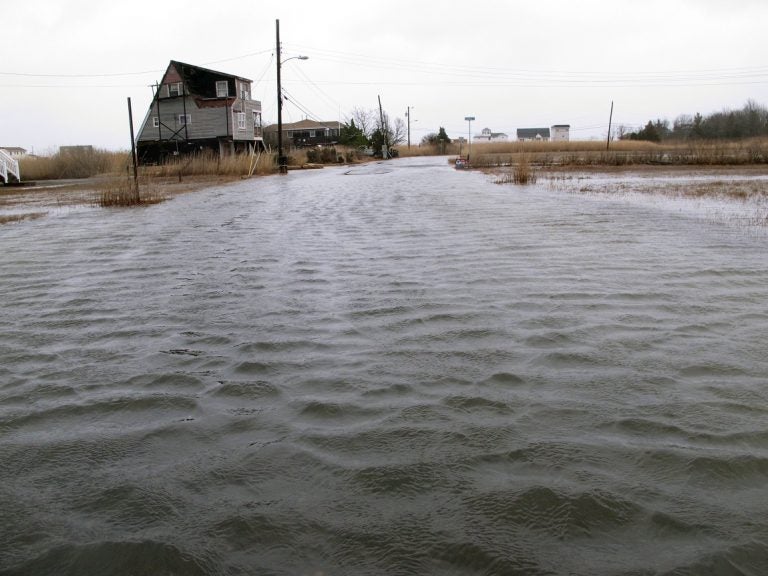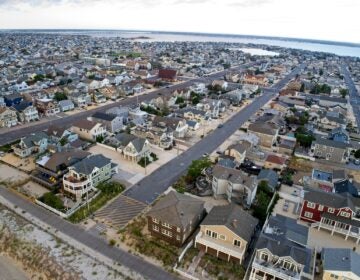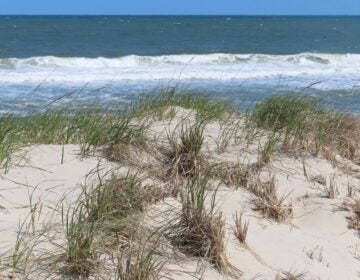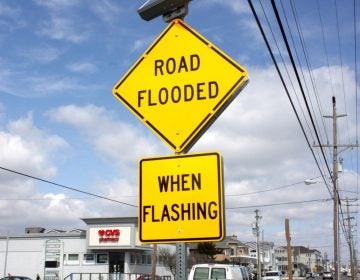Jersey Shore towns see more ‘sunny-day’ floods as seas rise, federal report says
Atlantic City and Cape May are among the coastal communities most exposed.

This March 14, 2017, photo shows the flooded streets of a back bay neighborhood in Manahawkin N.J., after a moderate storm. (AP Photo/Wayne Parry)
This article originally appeared on NJ Spotlight.
—
Towns up and down the Jersey Shore are being exposed to increased flooding as a result of sea-level rise rather than storms, according to a new federal report.
What’s now known as high-tide flooding (HTF) is a growing threat for coastal communities around the country, especially along the Northeast Atlantic coast from Maine to Virginia, which is expected to see more of that type of flooding than other regions over the next year, according to the report from the National Oceanographic and Atmospheric Administration (NOAA).
The report cited data from tide gauges at Sandy Hook, Atlantic City and Cape May as showing an increasing number of days over the last 20 years when tides were more than half a meter above the average high-tide level. And it forecast the numbers will rise further as ocean levels increase, causing more flooding.
The report predicts six to 11 days of high-tide flooding in the Northeast from May 2020 to April 2021, more than any other region.
“Evidence of a rapid increase in sea level rise-related flooding started to emerge about two decades ago, and it is now very clear,” it said. “This type of coastal flooding will continue to grow in extent, frequency, and depth as sea levels continue to rise over the coming years and decades.”
Effects of high-tide flooding
The effects will include flooding of, and restriction of access to, homes; damage to roads and wastewater systems, and downward pressure on real estate values, the report said.
HTF is also known as “nuisance” or “sunny-day” flooding because it is typically not driven by storms but by a full moon or tidal currents that swell the existing effect of higher sea levels.
Atlantic City saw nine HTF days last year, up from five in 2000, and the number is expected to increase to between eight and 14 days this year. By 2030, HTF days are projected to rise to 20 to 35, and accelerate to as many as 155 by the end of the century.
At Sandy Hook, one of three New Jersey tide gauges NOAA used, the number of HTF days more than doubled to 11 between 2000 and 2019, and the number of such floods is expected to rise to between 10 and 15 this year. The forecast is similar for Cape May, which experienced seven HTF days last year and is expected to see between six and 11 this year. The peak season for high-tide flooding at all three New Jersey sites is the fall, NOAA said.
It follows a report by the Science and Technical Advisory Panel, a Rutgers University-led group, which said last year that seas rose 1.5 feet at the Shore over the last century, almost three times as much as the global mean sea level, as land subsidence amplified the effect of rising ocean waters along the mid-Atlantic coast.
By 2050, the panel forecast that seas at the Shore will rise by between 0.9 and 2.1 feet from 2000 levels. According to a modeling tool by Climate Central, a Princeton-based research group, a 2.1-foot rise would flood many areas of the Shore including parts of Atlantic City, Strathmere, Stone Harbor and Avalon as well as most of New Jersey’s Delaware Bay shore from Cape May as far north as Salem.
HTF is most commonly seen when ocean water bubbles out of storm drains, flooding streets and threatening homes and businesses, the report said. It warned that the phenomenon will become more frequent in coming years as seas rise.
Triggering record alerts
The National Weather Service is issuing record numbers of alerts for coastal flooding without a storm being present, the report said. The kind of flooding that in previous decades only occurred if there was a severe storm can now be triggered by a full moon or a change in the prevailing wind or ocean current, it noted.
“This will become the new normal unless coastal flood-mitigation strategies are implemented or enhanced,” it said. “Communities are investing in coastal infrastructure upgrades and adaptation strategies to address current flooding issues, but concerns regarding property access and future valuation/exposure, business disruption, public health, and other such concerns are growing.”
Nationally, the report predicted that the frequency of HTF will double or triple over the current decade, and by 2050 will be as much as 15 times higher than the current rate.
Rising seas were among a wide range of effects identified by New Jersey’s latest report on climate change, issued by the state Department of Environmental Protection on June 30.
Science behind climate change
The NOAA report gives additional weight to the DEP report because it’s a scientific assessment by a professional body coming out of a presidential administration that denies climate change, said Jeff Tittel, director of the New Jersey Sierra Club.
“They are professionals and scientists who have been doing this a long time no matter who is in the White House, and when they come out with a report like this, you should read it and understand that it’s alarming,” Tittel said.
He called the NOAA report another wakeup call for coastal communities where people are already having to move their cars to higher ground during high-tide flooding, and in the future will probably have to move them further. “At first, people had to move their cars one block to avoid the street flooding,” Tittel said. “Now, they are moving two or three blocks. It keeps getting worse and worse.”
The document shows the state government and coastal communities that they need to consider measures like retreating from the most flood-prone areas or building higher, Tittel said. He acknowledged that regulating such moves will be politically challenging but will become inevitable as rising seas encroach further on coastal development.
“It is a heavy lift but if we don’t do it, what’s the future going to be?” he said. “It’s going to be Superstorm Sandy every couple of years, and billions of dollars in lost revenue and lost ratables.”
Tittel urged the DEP to restrict coastal development in its current wide-ranging review of regulations that will respond to climate change. The review, called NJ PACT, or Protecting Against Climate Threats, is expected to be complete in the fall.

Get daily updates from WHYY News!
WHYY is your source for fact-based, in-depth journalism and information. As a nonprofit organization, we rely on financial support from readers like you. Please give today.





